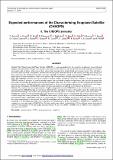Expected performances of the Characterising Exoplanet Satellite (CHEOPS) II. The CHEOPS simulator
Abstract
Context. The CHaracterising ExOPlanet Satellite (CHEOPS) is a mission dedicated to the search for exoplanetary transits through high precision photometry of bright stars already known to host planets. The telescope will provide the unique capability of determining accurate radii for planets whose masses have already been measured from ground-based spectroscopic surveys. This will allow a first-order characterisation of the planets’ internal structure through the determination of the bulk density, providing direct insight into their composition. By identifying transiting exoplanets with high potential for in-depth characterisation, CHEOPS will also provide prime targets for future instruments suited to the spectroscopic characterisation of exoplanetary atmospheres. Aims. The CHEOPS simulator has been developed to perform detailed simulations of the data which is to be received from the CHEOPS satellite. It generates accurately simulated images that can be used to explore design options and to test the on-ground data processing, in particular, the pipeline producing the photometric time series. It is, thus, a critical tool for estimating the photometric performance expected in flight and to guide photometric analysis. It can be used to prepare observations, consolidate the noise budget, and asses the performance of CHEOPS in realistic astrophysical fields that are difficult to reproduce in the laboratory. Methods. The simulator has been implemented as a highly configurable tool called CHEOPSim, with a web-based user interface. Images generated by CHEOPSim take account of many detailed effects, including variations of the incident signal flux and backgrounds, and detailed modelling of the satellite orbit, pointing jitter and telescope optics, as well as the CCD response, noise and readout. Results. The simulator results presented in this paper have been used in the context of validating the data reduction processing chain, in which image time series generated by CHEOPSim were used to generate light curves for simulated planetary transits across real and simulated targets. Independent analysts were successfully able to detect the planets and measure their radii to an accuracy within the science requirements of the mission: for an Earth-sized planet with an orbital period of 50 days orbiting a Sun-like target with magnitude V = 6, the median measured value of the planet to star radius ratio, Rp/Rs, was 0.00923 ± 0.00054(stat) ± 0.00019(syst), compared to a true input value of 0.00916. For a Neptune-sized planet with an orbital period of 13 days orbiting a target with spectral type K5V and magnitude V = 12, the median measured value of Rp/Rs was 0.05038 ± 0.00061(stat) ± 0.00031(syst), compared to a true input value of 0.05.
Citation
Futyan , D , Fortier , A , Beck , M , Ehrenreich , D , Bekkelien , A , Benz , W , Billot , N , Bourrier , V , Broeg , C , Collier Cameron , A , Deline , A , Kuntzer , T , Lendl , M , Queloz , D , Rohlfs , R , Simon , A E & Wildi , F 2020 , ' Expected performances of the Characterising Exoplanet Satellite (CHEOPS) II. The CHEOPS simulator ' , Astronomy & Astrophysics , vol. 635 , A23 . https://doi.org/10.1051/0004-6361/201936616
Publication
Astronomy & Astrophysics
Status
Peer reviewed
ISSN
0004-6361Type
Journal article
Description
Funding: European Research Council (ERC) under the European Union’s Horizon 2020 research and innovation programme (project FourAces; grant agreement No 724427). It has also been carried out in the frame of the National Centre for Competence in Research PlanetS supported by the Swiss National Science Foundation (SNSF); the Swiss Space Office (SSO).Collections
Items in the St Andrews Research Repository are protected by copyright, with all rights reserved, unless otherwise indicated.

